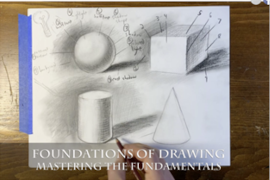Foundations of Drawing is an online drawing course suitable for middle-school students through adults. The course material looks like it will be easy at first since students will work primarily with circles, cubes, cylinders, and cones. But in even the early lessons on drawing a sphere, artist Kevin McEvoy teaches advanced techniques for shading, lighting, and shadows so that students learn how to create realistic 3D effects.
Students will need an assortment of six drawing pencils, a sketchpad, a kneaded eraser, a hard eraser, blender sticks, a metal sharpener, a potato peeler, and a sanding board. (The last three items are for sharpening pencils.) The McEvoy Atelier sells an inexpensive drawing kit with these items.
The course is presented in four main sections: Materials, Beginning to Draw with Shapes, Perspective 3D Shapes, and Geometric Essence. Within each section are one or more video lessons taught by Kevin McEvoy. The first section regarding materials has a few short videos covering topics such as different ways to sharpen art pencils, art erasers, and the selection of pencils by hardness to produce a range of tones. McEvoy assumes that students already know how to draw the outlines of the geometric shapes. The emphasis in this course is on making those figures appear to have three dimensions.
Beginning with “How to Draw a Sphere,” the first lesson in the third section, the videos are lengthier. But none run more than a half hour. When he’s finished with each drawing, McEvoy labels the various aspects of each drawing: halftones, highlights, background, external contour, shadow shape, cast shadow, and reflected light. Students will then complete their own drawings, labeling them in the same fashion.
The detailed instruction is great for serious art students. McEvoy says that the skills taught in this course are the “geometric essence of all of drawing and painting,” and aspiring artists will begin to identify the geometric shapes in almost everything.
In most of the lessons, McEvoy also teaches about a famous artist and his techniques in relation to what students are learning. The video lessons are supported by downloadable PDFs that sum up the key principles and art vocabulary taught in that lesson. In addition, “Art History Reference Image” sections provide the images shown in the video and additional information about the featured artist. In two videos toward the end of the course, McEvoy analyzes images by well-known artists in terms of the geometric shapes within them to show why mastering these basic shapes is foundational. It is important to note that there are no nude images in any of The McEvoy Atelier courses, and there are no links to other websites, so students are not exposed to anything objectionable.
The instruction and the pacing are excellent. I found it easy to follow along, usually working on my own drawing while watching and occasionally pausing. Some students will prefer to watch and then work on their own drawings.
I did run into a few technological glitches in the progression from lesson to lesson. I often had to back out of a lesson and into it again to get it to show the “mark complete” button before it would let me advance.
McEvoy recommends following Foundations of Drawing with his other courses in this order:
- Drawing from Life
- Foundations of Painting
- Still Life Drawing
- Still Life Painting
- Portrait Drawing
- Portrait Painting
Other courses will be added in the future. In these succeeding courses, students will learn to work with charcoal and oil paints. The materials for oil painting start to get expensive, but McEvoy provides detailed materials lists with annotated links to sources and occasional notes about less expensive options. He also has separate lists for “Fundamental Painting Supplies” and “Advanced Painting Supplies,” with the fundamental list providing less-expensive options suitable for the beginner.
The McEvoy Atelier website explains that their courses are designed for independent learning. They say that for every half hour of video, there should be about two hours of off-screen activity, although much depends on the student's ability, speed, and skill level. In Foundations of Drawing, the off-screen work didn't take me four times as long as the video, because I usually worked along with the videos, pausing as needed. While I’m not an accomplished artist, I have enough experience to be able to work more quickly than many students. I would guess that most students will need about an hour to an hour and a half of activity for every half hour of video for Foundations of Drawing. Time required for activities will likely increase significantly once students start working with oil paints since the materials themselves require more prep and clean-up time and are more challenging to handle.
Students pay a monthly subscription fee and have access to all courses as well as the Feedback Friday Facebook Group where they can ask questions. Other family members can use the same subscription at no extra cost. (Check with McEvoy Atelier for the cost for group classes.) Personal lessons are also available at extra cost.








